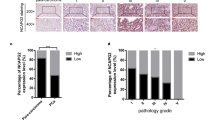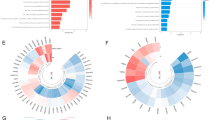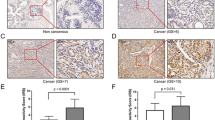Abstract
Objective
Chaperonin-containing tailless complex polypeptide 1 subunit 6A (CCT6A) involves several solid cancers’ development and progression, while its clinical utility in prostate cancer management is rarely revealed. Consequently, the present study intended to investigate the linkage of CCT6A with disease features, treatment information, and prognosis of surgical prostate cancer patients.
Methods
CCT6A in 220 surgical prostate cancer patients was determined via immunohistochemistry. Additionally, survival analyses on data from the public databases were performed to validate the prognostic value of CCT6A further.
Results
CCT6A expression was upregulated in tumor tissue than in adjacent tissue (P < 0.001). Increased CCT6A was related to elevated Gleason score (P < 0.001) and pathological T stage (P = 0.029). CCT6A was increased in patients with positive surgical margin status (vs. negative) (P = 0.029) and patients with adjuvant external-beam radiation therapy (vs. no) (P = 0.001). Concerning the prognostic value, high tumor CCT6A was linked with shortened disease-free survival (DFS) (P = 0.009), which was also validated through further Cox’s proportional hazard regression model analyses (hazard ratio: 2.695, 95% CI: 1.086–6.683, P = 0.032), whereas CCT6A was not correlated with overall survival (OS) (P > 0.050). Additionally, the Gene Expression Profiling Interactive Analysis database indicated that high tumor CCT6A was related to shortened DFS (P = 0.036), but it was not associated with OS (P > 0.050); meanwhile, the Human Protein Atlas database suggested that high tumor CCT6A was linked with reduced OS (P = 0.048).
Conclusion
Tumor CCT6A high expression correlates with the elevated Gleason score, pathological T stage, and shortened DFS in surgical prostate cancer patients.




Similar content being viewed by others
Data availability
The original contributions presented in the study are included in the article/supplementary material; further inquiries can be directed to the corresponding author/s.
References
Sandhu S, Moore CM, Chiong E et al (2021) Prostate cancer. Lancet 398(10305):1075–1090
Gandaglia G, Leni R, Bray F et al (2021) Epidemiology and prevention of prostate cancer. Eur Urol Oncol 4(6):877–892
Sung H, Ferlay J, Siegel RL et al (2021) Global Cancer Statistics 2020: GLOBOCAN estimates of incidence and mortality worldwide for 36 cancers in 185 countries. CA Cancer J Clin 71(3):209–249
Xia C, Dong X, Li H et al (2022) Cancer statistics in China and United States, 2022: profiles, trends, and determinants. Chin Med J (Engl) 135(5):584–590
Parker C, Castro E, Fizazi K et al (2020) Prostate cancer: ESMO clinical practice guidelines for diagnosis, treatment and follow-up. Ann Oncol 31(9):1119–1134
Rebello RJ, Oing C, Knudsen KE et al (2021) Prostate cancer. Nat Rev Dis Primers 7(1):9
Atallah C, Toi A, van der Kwast TH (2021) Gleason grade 5 prostate cancer: sub-patterns and prognosis. Pathology 53(1):3–11
Yang CW, Wang HH, Hassouna MF et al (2021) Prediction of a positive surgical margin and biochemical recurrence after robot-assisted radical prostatectomy. Sci Rep 11(1):14329
Zhang B, Zhou J, Wu S et al (2020) The impact of surgical margin status on prostate cancer-specific mortality after radical prostatectomy: a systematic review and meta-analysis. Clin Transl Oncol 22(11):2087–2096
Shabanov MA, Potapova AV, Gladilina IA, Rotobelskaya LE (2020) Morphological criteria for progression risk in patients with prostate cancer after radiation therapy. Urologiia 1:68–74
Zeng G, Wang J, Huang Y et al (2019) Overexpressing CCT6A contributes to cancer cell growth by affecting the G1-To-S phase transition and predicts a negative prognosis in hepatocellular carcinoma. Onco Targets Ther 12:10427–10439
Ying Z, Tian H, Li Y et al (2017) CCT6A suppresses SMAD2 and promotes prometastatic TGF-beta signaling. J Clin Invest 127(5):1725–1740
Ma J, Yang L, Feng H et al (2021) CCT6A may act as a potential biomarker reflecting tumor size, lymphatic metastasis, FIGO stage, and prognosis in cervical cancer patients. J Clin Lab Anal 35(8):e23793
Jiang J, Liu C, Xu G et al (2021) CCT6A, a novel prognostic biomarker for Ewing sarcoma. Medicine (Baltimore) 100(4):e24484
Sun H, Wang Y, Jing HY et al (2021) Chaperonin-containing TCP1 subunit 6A is a prognostic potential biomarker that correlates with the presence of immune infiltrates in colorectal cancer. Front Genet 12:629856
Zhang T, Shi W, Tian K, Kong Y (2020) Chaperonin containing t-complex polypeptide 1 subunit 6A correlates with lymph node metastasis, abnormal carcinoembryonic antigen and poor survival profiles in non-small cell lung carcinoma. World J Surg Oncol 18(1):156
Fu H, Jin C, Zhu Q et al (2019) Dysregulated expressions of PTEN, NF-kappaB, WWP2, p53 and c-Myc in different subtypes of B cell lymphoma and reactive follicular hyperplasia. Am J Transl Res 11(2):1092–1101
Cai Y, Wu D, Zhan L (2022) CCT6A expression in hepatocellular carcinoma and its correlation with clinical characteristics, liver function indexes, tumor markers and prognosis. Clin Res Hepatol Gastroenterol 46(3):101796
Murillo-Garzon V, Kypta R (2017) WNT signalling in prostate cancer. Nat Rev Urol 14(11):683–696
Katoh M (2017) Canonical and non-canonical WNT signaling in cancer stem cells and their niches: cellular heterogeneity, omics reprogramming, targeted therapy and tumor plasticity (Review). Int J Oncol 51(5):1357–1369
Peng X, Chen G, Lv B, Lv J (2022) MicroRNA-148a/152 cluster restrains tumor stem cell phenotype of colon cancer via modulating CCT6A. Anticancer Drugs 33(1):e610–e621
Yang X, Tong Y, Ye W, Chen L (2022) HOXB2 increases the proliferation and invasiveness of colon cancer cells through the upregulation of CCT6A. Mol Med Rep 25(5)
Lysenko I, Mori K, Mostafaei H et al (2020) Prognostic value of gleason score at positive surgical margin in prostate cancer: a systematic review and meta-analysis. Clin Genitourin Cancer 18(5):e517–e522
Sanda MG, Cadeddu JA, Kirkby E et al (2018) Clinically localized prostate cancer: AUA/ASTRO/SUO guideline. Part I: risk stratification, shared decision making, and care options. J Urol 199(3):683–690
Hu M, Fu X, Si Z et al (2019) Identification of differently expressed genes associated with prognosis and growth in colon adenocarcinoma based on integrated bioinformatics analysis. Front Genet 10:1245
He T, Yu D, Wang Z et al (2022) Chaperonin-containing tailless complex polypeptide 1 subunit 6A links with aggravating tumor features and disease-free survival in surgical gastric cancer patients: a long-term follow-up study. Clin Res Hepatol Gastroenterol 101913
Author information
Authors and Affiliations
Contributions
YW contributed to the conception; SP and JY contributed to data acquisition; SP, JY, and YW contributed to data analysis, drafted the manuscript, and revised the manuscript. All authors read and approved the final manuscript.
Corresponding author
Ethics declarations
Ethics approval and consent to participate
The study was permitted by Ethics Committee. Patients signed the informed consent or provided oral agreement with tape recording; meanwhile, for patients who already died at the study initiation, their family members provided the informed consent.
Additional information
Publisher's Note
Springer Nature remains neutral with regard to jurisdictional claims in published maps and institutional affiliations.
Supplementary Information
Below is the link to the electronic supplementary material.
Rights and permissions
Springer Nature or its licensor (e.g. a society or other partner) holds exclusive rights to this article under a publishing agreement with the author(s) or other rightsholder(s); author self-archiving of the accepted manuscript version of this article is solely governed by the terms of such publishing agreement and applicable law.
About this article
Cite this article
Peng, S., Yu, J. & Wang, Y. CCT6A dysregulation in surgical prostate cancer patients: association with disease features, treatment information, and prognosis. Ir J Med Sci 193, 85–93 (2024). https://doi.org/10.1007/s11845-023-03461-z
Received:
Accepted:
Published:
Issue Date:
DOI: https://doi.org/10.1007/s11845-023-03461-z




